Mudras translate as gestures. They are physical positions of the whole body or parts of the body such as the hands which subtly alter the flow of prana, deepening the awareness and altering the mood. They may be practiced alone or in combination with certain asanas. Hand mudras can be used during pranayama and meditation.
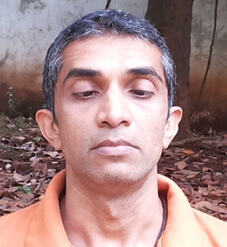
Agocharam - beyond sensory perception, unknown or invisible
Nasi – nose
Agra - tip
Drishti – gazing
Sit in a meditative asana with the hands in dhyana mudra. Close your eyes. Relax the body. Open the eyes and become aware of the tip of the nose. You should be able to see inverted V. If this is not visible, you can start with a finger on the tip to get the focus right (a red dot on the tip of the nose can also be used to gain focus). Concentrate on this point for about 10 seconds. Breathe normally. Close your eyes again. Warm up your hands and cover your eyes to relax the eyes. Continue the practice for a few minutes.
Do not over strain the eyes. Do not overdo the exercise as nausea might be felt and if it’s done for too long one may get a headache.
This practice is also practiced in a variation of Sarvangasan – shoulder stand pose.
In a sitting position or an asana such as tadagasan become aware of the anal sphincter. Breathing normally contract and relax the anus, holding for up to ten seconds if comfortable. Practice for a few minutes or until tired. Make sure the contraction and relaxation is smooth and without strain.
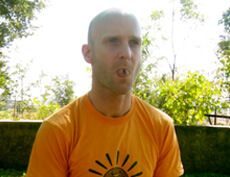
Kaki - crow
Sit in a meditative asana with the hands in chin or jnana mudra.
Make the mouth into a beak, with the tongue rounded, as in shitali.
Inhale slowly and fully. (It can be combined with Agochari and looking at the nose while inhaling).
Exhale while closing the eyes.
Repeat for a few minutes.
Do not practice if there is glaucoma, low blood pressure, cough or cold.
For diabetic retinopathy or recent eye operation one should consult an expert before practicing.
Sit in siddhasana, or any other comfortable meditative position
Turn the tongue to touch the back of the palate. Breathe normally.
This can be performed in Viparit Karni - Inverted Pose.
Mouth ailments may stop one from practicing this mudra.
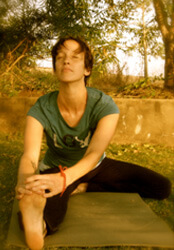
From sitting position, bend the left leg and sit on the heel. Keep the right leg out in front.
Hold toes of the right leg with both hands and keep the head facing forward.
Inhale with kaki and agochari mudra and bend the head a bit further back.
Hold the breath for as long as comfortable while applying khechari and shambhavi mudra, as well as moola bandha.
Exhale, close your eyes and straighten your upper body.
Practice from the other side
Practice a few rounds from both sides.
High blood pressure or heart complaints.
If eye diseases or recent eye operations, do not practice without an experts opinion.
Avoid during menstruation and pregnancy.
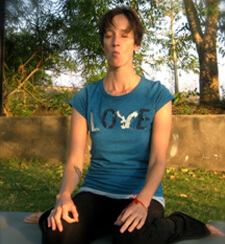
Sit in vajrasana with the heels on either sides of the buttocks and the toes pointing outwards. If this is uncomfortable then sit in vajrasana. Place the hands on the knees. Close the eyes and relax.
Move the tongue in front of the teeth with the mouth closed. The jaw should be relaxed. Start by moving the tongue to the left, right, up and down. Do this three times. Then rotate the tongue three times clockwise and three times anti-clockwise while touching the tongue to the mouth.
Perform with caution if there are problems with the ankles, knees or hips.
\
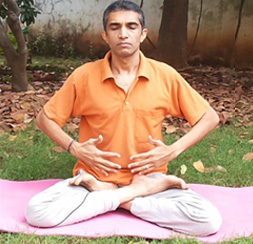
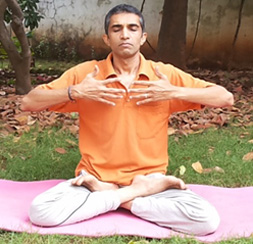
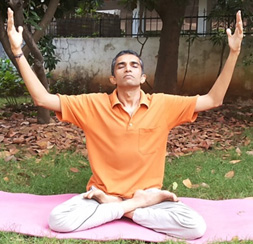
In a sitting position bring the hands in front of the lower belly, fingertips pointing towards each other, hands a little away from the body. Inhaling slowly bring the hands up over the belly, in front of the chest and up to the throat. Make sure not to touch the body. Holding the breath raise the arms up over the head, looking upwards then bring the hands back to the throat and exhaling slowly lower the hands down. Try to visualize and feel the movement of the prana moving up and down. Use ujjayi breathing if desired. When the arms are open focus on ajna chakra (the eyebrow centre) and sahasrara chakra (top of the head). Feel the prana entering the body. After practicing at least 7 times bring the hands in front of the body, palms facing each other and at a distance of 10-15 cms. Move the hands and try to feel the prana then place the hands on any part of the body to give more prana. Best to practice after pranayama.
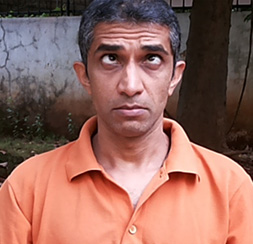
Eyebrow Centre Gazing
Shambhavi – Wife of Shiva or Shakti
Bhru – eye
Madhya – centre
Drishti - gazing
Sit in padmasan, siddhasan, or in any other meditative position with hands in dhyana mudra. Close the eyes and relax the body.
Open the eyes and focus on the eyebrow centre. A big V should be seen. If the V is distorted one eye might not be focusing properly, this might be due to flexibility of the eyes. Fully concentrate on this point for about 10 seconds. Do not strain the eyes. Close the eyes if there is any discomfort.
Close your eyes. Warm up the hands and cover the eyes to relax the eyes.
Repeat the practice for a few minutes.
Do not practice if there is glaucoma. If there are any major eye problems consult with an expert before practicing.
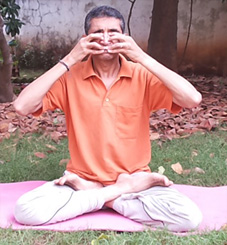
Shat – Six
Mukhi – openings
Sit in siddhasan or any comfortable sitting position.
Inhale, while performing kaki mudra as well as agochari mudra.
Hold the breath, close the eyes, and cover the ears with the thumbs, the eyes with the index fingers and the nose with the middle fingers. Press the upper lip slightly over the bottom lip with the ring and little fingers. Keep your focus on ajna chakra. (Moolha banda can be applied).
Remove the hands from the face and exhale with brahmari.
Inhale straight away again and practice these rounds for a few minutes.
If any pain is felt from performing the agochari mudra then avoid.
Place the fingers gently on the face.
For some people it can bring up strong emotions very fast and sometimes fear.
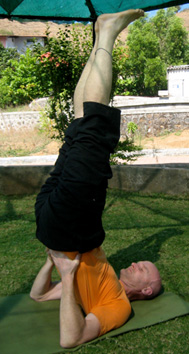
Come into viparit karani pose. Close your eyes.
First focus on breathing with ujjayi breath.
Then focus on abdominal breathing.
Move on to awareness of the following chakras: vishuddi and manipura. Apply jiva bandha (tongue to top palate) or khechari mudra for the whole practice of viparita karani mudra.
While inhaling move awareness from manipura to vishuddi chakra and while exhaling move the awareness from vishuddhi to Manipur chakra. Continue with this movement 21 times.
Then move the awareness to the navel region, to the abdominal breathing and to manipura chakra.
Keep breathing with ujjayi and with abdominal breathing throughout the practice.
High blood pressure, heart disease, neck or back pain. As per viparit karni, the asana.
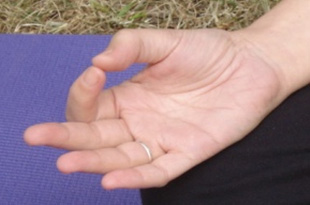
Place the hands on the knees. Turn the palms upward and touch the thumb to the top of the index finger. Let the fingers be relaxed.
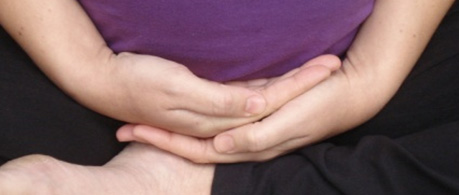
Place the left hand under the belly, palm facing upwards. Place the right hand on top, palm facing upwards. Let the arms be relaxed and hands rest in the lap.
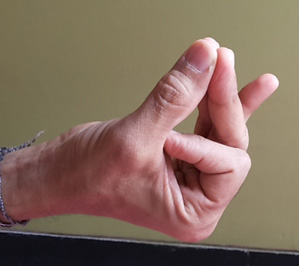
Place the hands on the knees, palms facing upwards. Bend the index finger and place it at the base of the thumb. One should be able to feel the pulse. Touch the thumb to the middle and ring fingers. Let the little finger be relaxed.
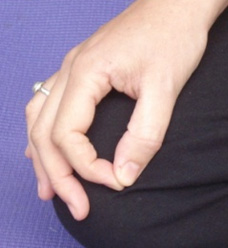
Place the hands on the knees. Turn the palms downward and touch the thumb to the top of the index finger. Let the fingers be relaxed.
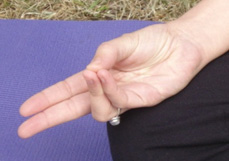
Place the hands on the knees. Turn the palms downward and touch the thumb to the ring and little fingers. Let the fingers be relaxed.
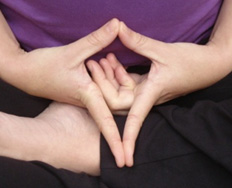
Bring the hands to the lap. Interlock the middle, ring and little fingers together. Press the thumbs and index fingers together. Move the thumbs and index fingers away from each other, forming a diamond shape.
Phone - +91-9822770727
E-mail - yoga@yogapoint.com or yogapoint108@gmail.com
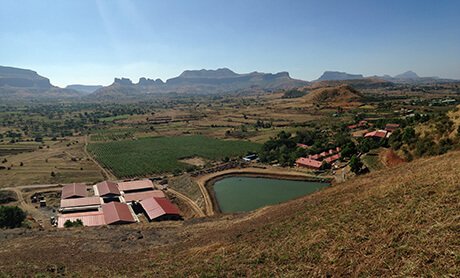
Yoga Vidya Dham, Kaivalya Nagari,
College Road, Nashik - 422005.
Maharashtra, India.
Phone - +91-9822770727 (for courses in ENGLISH)
+91-253-2318090 (For courses, in HINDI or MARATHI)
(Please call during 9.00 AM to 5 PM Indian Time)
E-mail - yoga@yogapoint.co or yogapoint108@gmail.com
Village Talwade, Trimbak, Nasik
Maharashtra,India.
Phone - +91-9822770727
E-mail - yoga@yogapoint.com or yogapoint108@gmail.com